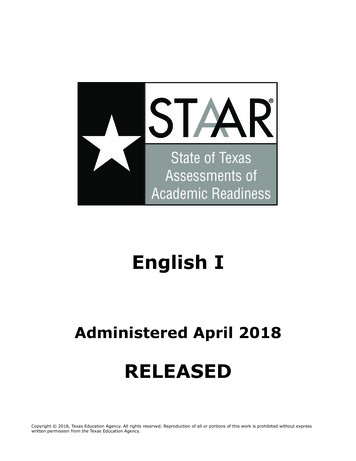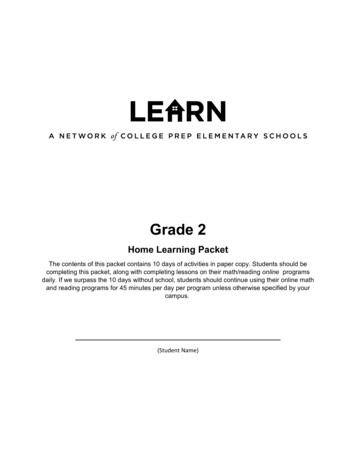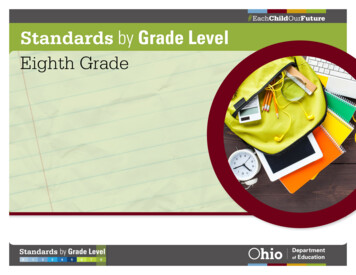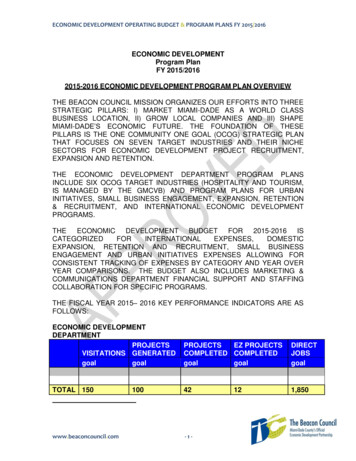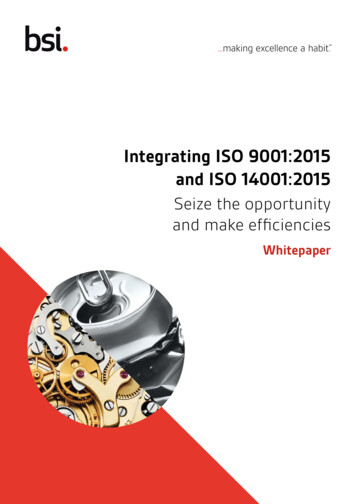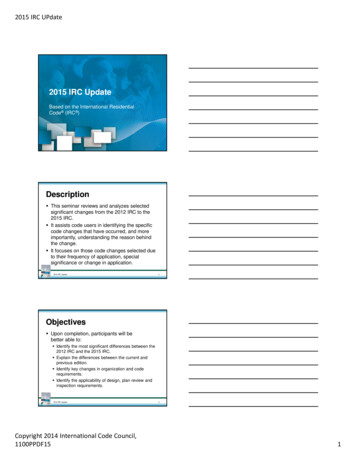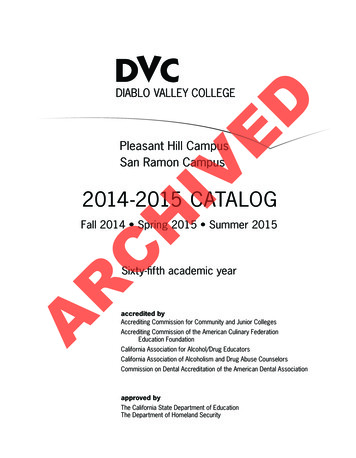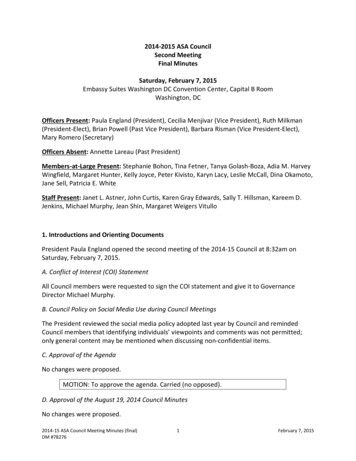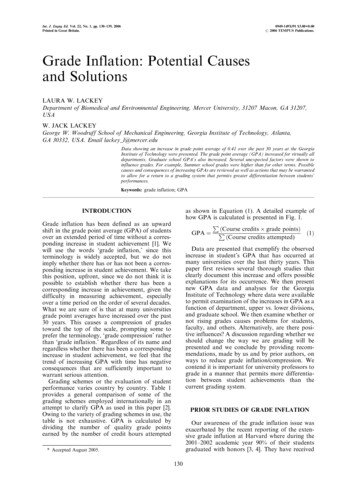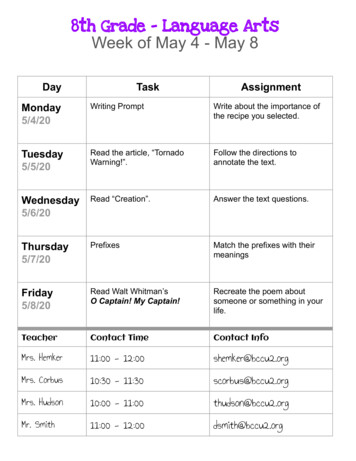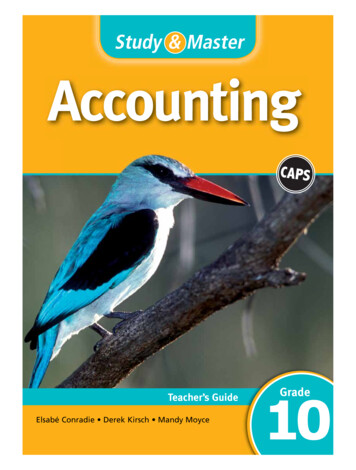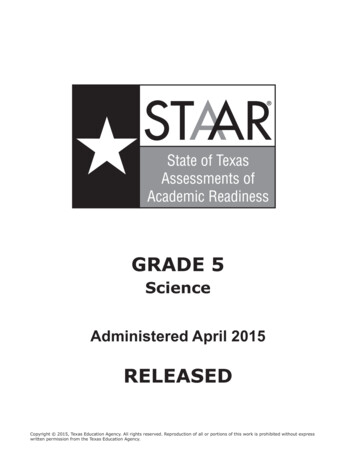
Transcription
GRADE 5ScienceAdministered April 2015RELEASEDCopyright 2015, Texas Education Agency. All rights reserved. Reproduction of all or portions of this work is prohibited without expresswritten permission from the Texas Education Agency.
SCIENCEPage 3
DIRECTIONSRead each question carefully. For a multiple-choice question, determine thebest answer to the question from the four answer choices provided. For agriddable question, determine the best answer to the question. Then fill inthe answer on your answer document.1Many people ride a bicycle for fun and exercise. Some people ride a bicycle to workbecause it saves money and benefits the environment by reducing the use of fossilfuels.Which of these is not an example of the bicycle using mechanical energy?A The pedals, gears, and chain help turn the wheels.B The wheels turn when the bicycle moves.C The front wheel guides the bicycle as it moves.D The reflector allows the bicycle to be seen at night.Page 4GO ON
2A teacher gives a student four clear sealed containers. Each container holds adifferent substance. The student records some observations about the substance ineach container.Student ObservationsContainerObservations1The substance takes the shape of thecontainer and is clear. Small particlesfloat on top of the substance.2The substance is hard and cube-shaped.The surface of the substance is shiny.3The substance is not visible, and thecontainer appears empty.4The substance is cold and made ofcrystals.Based on these observations, which container most likely holds only gas?F Container 1G Container 2H Container 3JContainer 4Page 5GO ON
3A farmer keeps bees to pollinate crops. The farmer makes several observations aboutthe bees. Bees make return trips to drink sugar water from abowl placed 40 meters from their hive. Bees have dark eyes and black-and-yellow stripes. Bees produce honey from the nectar they collect. Bees will sting when threatened or disturbed.Which of these observations describes a learned behavior?A Bees make return trips to drink sugar water from a bowl placed 40 meters fromtheir hive.B Bees have dark eyes and black-and-yellow stripes.C Bees produce honey from the nectar they collect.D Bees will sting when threatened or disturbed.Page 6GO ON
4A group of students built the circuit shown below. BatteryBulbBellThe lightbulb does not glow. Which statement explains this observation?F The battery is not charged.G The lightbulb is not part of a complete circuit.H The circuit does not have a switch.JThe bell uses most of the energy from the battery.Page 7GO ON
R R/FotoliaThe whiskers of a river otter and the antennae of a cockroach are shown below. photobypixie777/Fotolia5How do structures such as whiskers and antennae benefit organisms?A They help the organisms detect their surroundings.B They help the organisms eat food quickly.C They help the organisms fight predators.D None of thesePage 8GO ON
6A student looks into a mirror and sees an image of an object. Which diagram showsan X where the object is most likely StudentStudent7An energy company wants to build a hydroelectric power plant. Which of thesecharacteristics of an area is most important to the development of a hydroelectricpower plant?A The area has a cool, rainy climate.B The area is located in a valley with very little wind and frequent heavy fog.C The area has a river that flows rapidly from nearby mountains through a valley.D The area has no geysers or hot springs.Page 9GO ON
8Some students investigate the properties of four objects using a hand lens, amagnet, and a beaker containing water. Their observations are recorded in the table.Observed PropertiesObjectMass (g)Observations Light brownCork2 Has small holes Floats in water BlueMarble2 Shiny Sinks in water Light brownWood cube2 Not attracted by a magnet Floats in water BlackRubber stopper2 Sinks in water Not attracted by a magnetWhich statement identifies a property that could be used to classify these objects intotwo different groups?F Density can be used to separate objects that sink in water from objects that donot.G Magnetism can be used to separate objects that are attracted by a magnet fromobjects that are not.H Solubility can be used to separate objects that dissolve in water from objects thatdo not.JPhysical state can be used to separate objects that are solids from objects thatare not.Page 10GO ON
DPage 11 sumikophoto/Fotolia Eric Isselée/Fotolia Anna Omelchenko/Fotolia mgkuijpers/Fotolia Aaron Amat/Fotolia sandpiper/Fotolia Konrad Reszka/Fotolia Mike V. Shuman/Shutterstock Aaron Amat/FotoliaC Four Oaks/ShutterstockB Derrick Neill/Fotolia Silver/Fotolia Eduardo Rivero/Fotolia Eric Isselée/Fotolia Sebastian Duda/FotoliaA Dave/Fotolia9An African savanna is a grassland with shrubs and a few small trees. It has warmtemperatures all year long, a dry winter season, and a rainy summer season. Whichgroup of animals is most likely supported by an African savanna?GO ON
10 Some characteristics of objects in the solar system are listed below.Characteristics of Some Objects inthe Solar System The core temperature is 15 million degrees Celsius. Meteor craters can be found on the surface. The source of light is the sun. Water covers most of the surface. Rocks and dust can be found on the surface.Which of the listed characteristics describe both Earth and the moon? The core temperature is 15 million degrees Celsius.F Meteor craters can be found on the surface. Water covers most of the surface. Rocks and dust can be found on the surface. Meteor craters can be found on the surface.G The source of light is the sun. Rocks and dust can be found on the surface. The core temperature is 15 million degrees Celsius.H Water covers most of the surface. Rocks and dust can be found on the surface. Meteor craters can be found on the surface.J The source of light is the sun. Water covers most of the surface. Rocks and dust can be found on the surface.Page 12GO ON
11 The table below lists ways that four organisms obtain energy.Methods for Obtaining EnergyOrganismMethodOak treeMushroomCottontail rabbitMountain lionProduces food through photosynthesisAbsorbs nutrients from decomposing plants and animalsEats grasses, twigs, and barkPreys on deer, wild hogs, and rodentsWhich organism obtains energy without depending on another organism?A Oak treeB MushroomC Cottontail rabbitD Mountain lion12 A student observed liquid wax dripping down the side of a burning candle. Afterputting out the candle’s flame, the student left the room. Several hours later thestudent observed that there was no longer any liquid on the side of the candle.Which statement explains what most likely happened to the liquid wax?F The heat given off by the flame caused the candle wax to evaporate.G The liquid wax changed back into a solid as it cooled.H The liquid wax condensed and was absorbed by the candle.JNone of the abovePage 13GO ON
13 Which statement best describes the relationship between humans and plants in thecarbon dioxide–oxygen cycle?A Humans depend on oxygen released into the air by plants, and plants depend oncarbon dioxide that humans release into the air.B Plants produce carbon dioxide as a product of photosynthesis and release it intothe air to provide energy for humans.C Plants depend primarily on energy supplied by oxygen for photosynthesis, aprocess which releases carbon dioxide needed by humans.D Humans and plants use gases in the air and the energy of sunlight to producetheir own food.Page 14GO ON
14 A student studies two Texas maps that showed some high temperatures for two daysin October 2012.High Temperatureson October 5, 2012High Temperatureson October 12, 201222 C27 CLubbockLubbockSan Antonio 31 C31 C33 CHoustonBrownsvilleSan Antonio30 C33 C32 CHoustonBrownsvilleSource: The Old Farmer’s AlmanacHow many degrees Celsius did the high temperature increase in the city that had thegreatest change in high temperature?Record your answer and fill in the bubbles on your answer document. Be sure to usethe correct place value.Page 15GO ON
15 A student adds 10 grams of four different powdered solids into four different beakers.The student then adds 100 mL of water to each beaker, stirs the mixtures, and allowsthem to sit for half an hour before recording observations. Which question is thestudent most likely trying to answer with this investigation?A At what water temperature do the substances dissolve?B How much water is needed to cause a substance to change state?C What causes a substance to sink when put in water?D Which substances dissolve in water?16 Many types of fans are used in homes. One type of electric fan is shown below.In addition to mechanical energy, which of these is produced as electric currentpasses through the circuit of this fan?F HeatG MassH LightJWater vaporPage 16GO ON
17 A freshwater ecosystem has various food webs. One of these food webs is ipodsCatfishDecayingplantsBassCrayfishWhich organisms transfer the most energy within the food web?A Bass, because they are predators in this webB Copepods, because they support two chains in this webC Crayfish, because they are at the bottom of this webD Algae, because they are the producers in this webPage 17GO ON
18 A student draws diagrams of her house and the location of the sun in the sky. Whichdiagram below does not correctly represent the location of the sun at the timeindicated?FHGJPage 18GO ON
19 The diagram below shows a fish being viewed from above the water.Apparent depthReal depthThe fish appears to be closer to the surface than it really is. What causes thisdifference?A Light is reflected.B Light is refracted.C Light is focused.D Light is blocked.20 Fossil fuels formed over long periods of time after particles in water settled to thesea floor and formed marine mud. What kinds of particles needed to be present inthe marine mud in order for fossil fuels to form?F Mostly sand and a few small bits of woodG Mostly decaying organismsH Mostly lava and a few sedimentary rocksJMostly metal mineralsPage 19GO ON
21 The table below lists the preferred diet of several types of birds.Preferred Diets of BirdsType of BirdPreferred DietAmerican goldfinchSeeds from grasses and wildflowersEastern bluebirdA large variety of insectsLesser goldfinchSeeds from sunflower plantsPurple martinWinged insectsYellow warblerCaterpillars, moths, mosquitoes, and beetlesBased on this information, which two types of birds do not compete for foodresources?A Purple martin and yellow warblerB Eastern bluebird and purple martinC Lesser goldfinch and eastern bluebirdD American goldfinch and lesser goldfinchPage 20GO ON
iStockphoto.com/Darren Green22 The photograph below shows a canyon in northern Arizona.Canyon wallsWhich of these describes how this canyon was most likely formed?F Floods eroded the sandstone away from the canyon walls.G Glaciers eroded the canyon rock as they melted and moved.H Ice wedged into cracks in the rock and weathered the canyon walls.JWind blew large rocks that smashed against the canyon walls.Page 21GO ON
121323 A student classifies the objects shown based on their physical properties.910115784635Penny4223Cotton ball0cm11.0 inKeyEraserIron nailPlastic rulerMetal paper clipRubber bandWhich property cannot be used to classify these objects into more than one group?A MagnetismB MassC Electrical conductivityD Solubility in waterPage 22GO ON
24 Some students examined two samples of pond water with a hand lens over threedays. Each day they compared what they saw with pictures of samples their teacherhad labeled. Their observations are listed below. On Day 1 the students identified mosquito eggs and mosquito larvaein one water sample and dragonfly nymphs in the other watersample. On Day 2 the students saw that the mosquito larvae had curled upand stopped moving. On Day 3 the students saw that a dragonfly with wings had developedfrom one of the nymphs.Based on their observations, the students concluded that mosquitoes undergocomplete metamorphosis while dragonflies undergo incomplete metamorphosis.Which of these explains why the students’ conclusion is correct?F The mosquito life cycle includes larvae that become pupae, while the dragonfly lifecycle includes adults that develop directly from nymphs.G The mosquito life cycle includes larvae with wings, while the dragonfly life cycleincludes nymphs.H The mosquito life cycle includes eggs that hatch in water, while the dragonfly lifecycle includes nymphs that develop in water.JThe mosquito life cycle includes nymphs that hatch from eggs, while the dragonflylife cycle includes adults that develop directly from larvae.Page 23GO ON
25 A simplified diagram of a system using solar energy is shown.R STTo recharge the battery for later use without lighting the bulb, which of the followingswitches should be closed?A Switch S onlyB Switches R and S onlyC Switches R and T onlyD Switches R, S, and TPage 24GO ON
26 Resources can be classified as renewable or nonrenewable. Which of these resourcesis classified in the same category as coal?F WoodG WindH Corn oilJPetroleum27 A student observes the following activities while walking in a park. AAAAfire ant digging a tunnel in sandy soilblue jay drinking water from a puddlebee collecting pollen from a treehawk circling in the air over a treeWhich of these living organisms was interacting with another living organism in theenvironment?A Fire antB Blue jayC BeeD HawkPage 25GO ON
28 A scientist was studying a type of event that occurred on Earth in various placeswithin a 30-day period. The circles indicate where the events happened.EquatorNWE5,000 kmSThe events being studied involved rapid changes to Earth’s surface at the locationsshown on the map. What type of event do the circles on the map m
Bass, because they are predators in this web; B; Copepods, because they support two chains in this web; C; Crayfish, because they are at the bottom of this web ; D; Algae, because they are the producers in this web; Page 18; GO ON 18; A student draws diagrams of her house and the location of the sun in the sky. Which diagram below does ; not; correctly represent the location of the sun at the .
